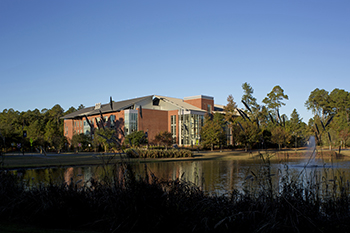 ATLANTA — Georgia Southern University’s new 151,000-square-foot Biological Sciences Building was recently awarded LEED Gold certification by the U.S. Green Building Council (USGBC) and verified by the Green Building Certification Institute (GBCI).
ATLANTA — Georgia Southern University’s new 151,000-square-foot Biological Sciences Building was recently awarded LEED Gold certification by the U.S. Green Building Council (USGBC) and verified by the Green Building Certification Institute (GBCI).
Atlanta-based SLAM Collaborative (SLAM), a 150-member architecture firm, planned and designed the $34.2 million facility. SLAM’s president, Robert F. Pulito, highlights that SLAM was one of the first 100 firms nationally to support the American Institute of Architects’ (AIA) “2030 Commitment to Carbon Neutrality Design and Practice” to achieve carbon-neutral buildings by 2030. The AIA 2030 Commitment is a voluntary program for AIA member firms to make a pledge, develop multi-year action plans, and implement steps that can advance carbon neutrality in both design and practice.
“This building demonstrates the university’s commitment to sustainability and will serve as a benchmark for future projects. It enables the Department of Biology to consolidate research and instruction in a state-of-the-art dedicated facility, which actively engages students in scientific exploration that will benefit both the local region and the state of Georgia,” Sidney P. Ward, AIA, LEED AP, a principal of The SLAM Collaborative said in a statement.
The Biological Sciences Building is itself a teaching tool for sustainability. A large high-definition video wall in the atrium is a dashboard that monitors and displays water and power usage along with air quality and room temperature, in real time. Strategically located exterior glazing allows light to penetrate deep into the building, and interior glazing enables passersby to see into research and instructional labs.
The building also handles storm-water runoff through bioswales, where water is cleaned before it moves on to rain chains directing water off the building. The bioswales serve both as storm-water management and a living lab. Additionally, all plantings, which were installed as a student project, are indigenous and were carefully selected to reduce irrigation requirements.
The campus’ first use of on-site renewable energy by means of photovoltaic panels to produce electricity will help to reduce the electrical power required from the electrical grid. Solar thermal panels will provide a portion of the domestic hot water, reducing the need for fossil fuel to supply the boilers.
The college is preparing for additional enrollment in the science, technology, engineering and math (STEM) fields. Predictions for enrollments during the next 10 years say that U.S. colleges and universities can expect to graduate an additional one million STEM majors.
“The key to meeting this goal is retaining students and keeping them interested in the fields,” said Martha Abell, Ph.D., dean of the College of Science and Mathematics said at the Biological Sciences Building’s opening ceremony. “This building, with its state-of-the-arts teaching labs and technology-enabled and active-learning classrooms, will support our efforts to produce more STEM graduates.”

